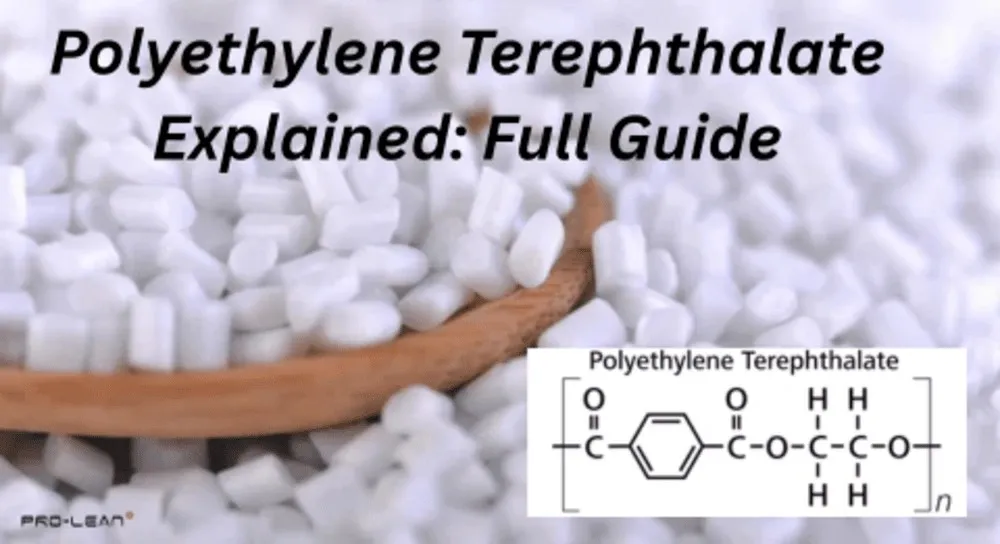
Polyethylene Terephthalate (PET) Explained
Polyethylene Terephthalate (PET) is a widely used plastic known for being strong, lightweight, and moisture-resistant.
What makes PET polymerspolyemrs special is theirits ability to be recycled and theirits versatility in various industries. ProleanTech uses advanced injection molding techniques to turn PET into high-quality parts and products. Our expertise ensures precision and efficiency, helping industries meet their needs with reliable, eco-friendly solutions.
In this article, we’ll explore what makes PET material properties such, how it’s used, and how manufacturers like ProleanTech play a role in bringing it to life. Whether you’re curious about its properties or how it fits into sustainable manufacturing, this guide has you covered.
PET Polyethylene Terephthalate Definition
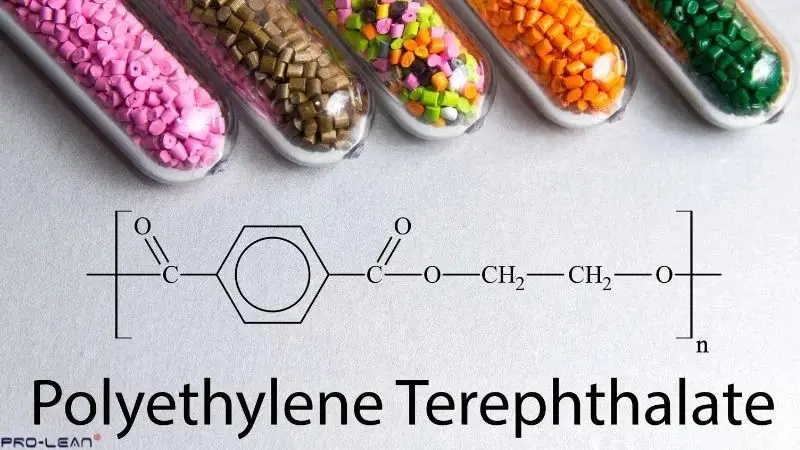
Polyethylene Terephthalate (PET)
When talking about what is PET material, it is a transparent, stiff, and durable plastic frequently used to package food and beverages because of its high strength-to-weight ratio. Moreover, its low weight reduces the transportation costs.
The PET logo is usually at the bottom of most grocery items, including water bottles, takeaway food containers, shampoo, and liquid soap. Even tennis balls and some textiles are made with it.
Initially created in the 1940s by DuPont researchers attempting to create novel synthetic fibres, the PET fibre was eventually dubbed “Dacron.”
Read this guide also: https://proleantech.com/foam-injection-molding/
How is PET ManufacturedPET is Manufactured?
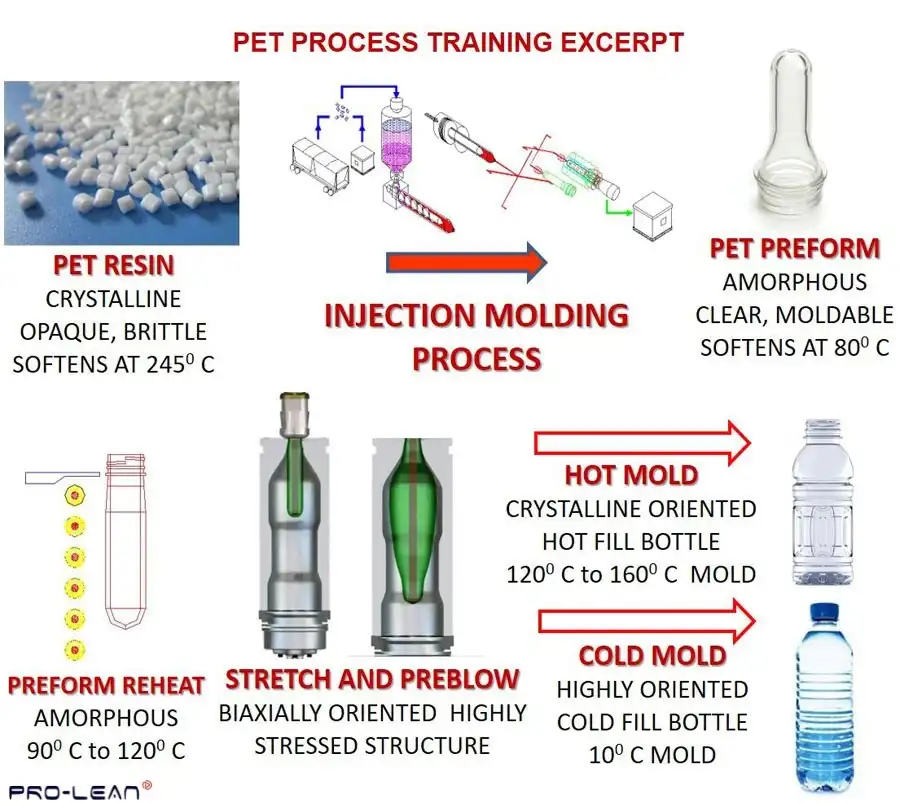
PET Bottle Manufacturing Process
PET makes up more than half of the synthetic fibres used worldwide.
Ethylene glycol and pure terephthalic acid are combined to create the polymer chain. PTA is derived from crude oil-based p-xylene, while MEG is typically derived from natural gas. Another method is to use MEG and dimethyl terephthalate (DMT) (C6H4(CO2CH3)2) to make PET.
A stabilizer and a catalyst are introduced during the PET-making process.
Besides this, a bluing ingredient, such as cobalt salt, also covers up any yellow tones. The strands, which will now resemble spaghetti after the chemical reaction, will be extruded so that the material can be processed and turned into whatever shape is required.
After cooling, the strands are chopped into tiny resin pellets that can be heated to facilitate plastic injection molding or extrusion. Understanding Injection Molding Cost is essential, too.
Try Prolean Now!
Benefits of PET Plastic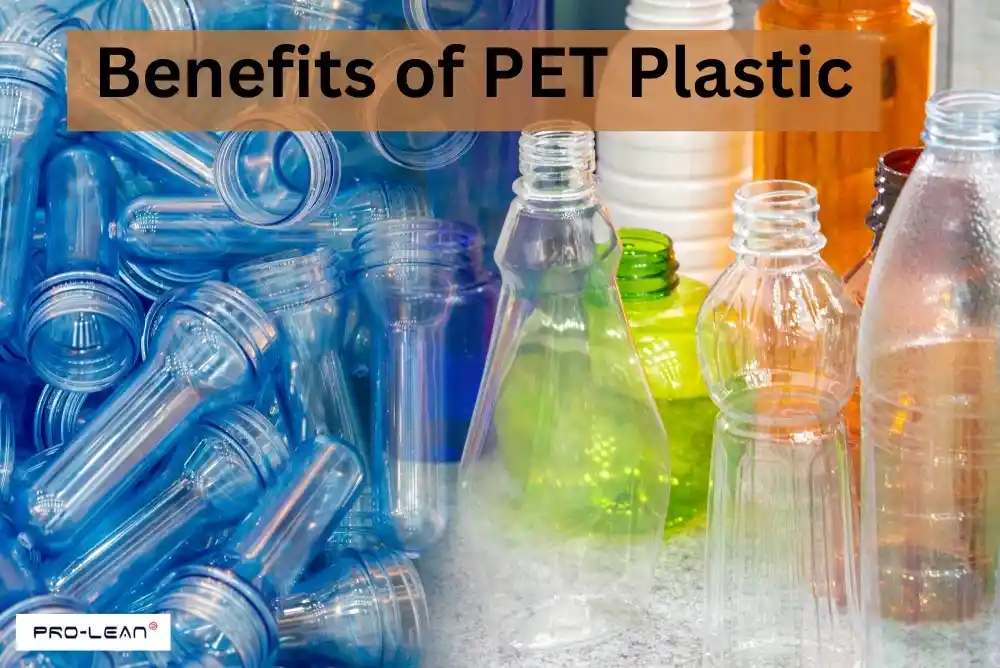
Benefits of PET Plastic
PET can be recycled because it liquefies rather than burns at high temperatures. It won’t break, shatter, or fracture and doesn’t absorb or interfere with microwave radiation, so many prepared meals are packaged in PET.
PET’s electrical insulating, gas (such as carbon dioxide and oxygen), and moisture barrier qualities are further benefits. It is not reactive with food or water, and it has a very low gas permeability, particularly with carbon dioxide.
Moreover, It can be utilized to create see-through products if it cools quickly. PET absorbs moisture from the air at high temperatures, and it can get even stronger if glass fibre is added for reinforcement.
- Operating range: 60°C–130°C
- Processing range: 120~220°C
- Glass transition: 67–81°C
- Melting point: 260°C
- Glass conversion: ~165°C
PET plastic products can only be injection molded using a screw-type machine, and its heat resistance is lower than other polymers. However, despite being recyclable, the material does not biodegrade.
Furthermore, after being stored for a long period, PET resin can oxidise and alter the flavour of foods and beverages packaged in PET.
Interesting read: Mastering hot runner injection molding for efficient output
Here are the physical properties of PET that gives it a unique position in the manufacturing industry.
| Property | Description |
| Chemical Formula | C10H8O4 |
| Density | ~1.38 g/cm³ |
| PET Melting Temp | ~250°C |
| Glass Transition Temp. | ~70–80°C |
| Thermal Conductivity | Low; acts as an insulator |
| Tensile Strength | High; ~55–75 MPa |
| Transparency | Naturally transparent; can be made opaque with additives |
| Moisture Absorption | Very low moisture absorption; excellent water resistance |
| Chemical Resistance | Resistant to acids, bases, and solvents but vulnerable to hydrolysis at high temperatures |
| Barrier Properties | Excellent barrier against gases (e.g., CO₂, O₂) and moisture |
| Electrical Properties | High electrical insulation resistance |
| Recyclability | Highly recyclable; often processed into fibers or containers (Recycle Code #1) |
| Applications | Bottles, food packaging, fibers for textiles, films, thermoformed containers |
| Environmental Notes | Lightweight; contributes to lower transport emissions but associated with microplastic concerns |
Read More: China Injection Molding: Advanced & Efficient Manufacturing Solutions
Polyethylene Terephthalate PET Grades
PET has different grades based on Injection molding: Types, applications, and benefits and that’s why their applications vary. Here’s an overview of Polyethylene terephthalate grades and their uses:
| Grade Name | Code | Description |
| PET 2070 | 2070 | High intrinsic viscosity (IV), suitable for bottles and containers. |
| PET 1101 | 1101 | General-purpose grade, often used in films and packaging. |
| PET 8200 | 8200 | High-strength fiber grade, used in textiles and industrial fibers. |
| PET 7352 | 7352 | Medium IV grade, ideal for thermoformed packaging. |
| PET 3300 | 3300 | High crystallinity grade for engineering plastics. |
| PET-G | G Series | Copolyester grade, improved toughness and transparency. |
| rPET 5000 | 5000 | Recycled PET grade, used in sustainable packaging. |
Read also: Compression Molding vs Injection Molding: Which is Best for You?
Try Prolean Now!
What is Polyethylene Terephthalate Used For?
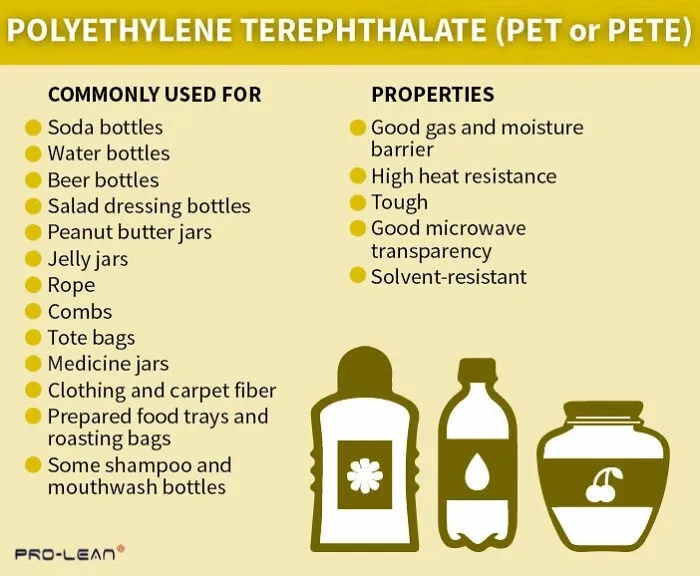
Polyethylene Terephthalate (PET) Uses and Properties
Due to its unique properties, PET has applications in different industries from food to textile and many more. Here are the common uses of PET in our daily life:
- Beverage bottles
- Food containers
- Synthetic fibers
- Plastic films
PET vs. HDPE
Here is a comparison of PET vs HDPE:
| Feature | Polyethylene Terephthalate (PET) | High-Density Polyethylene (HDPE) |
| Chemical Structure | Polyester made from terephthalic acid and ethylene glycol | Hydrocarbon polymer made from ethylene monomers |
| Density | ~1.38 g/cm³ | ~0.94–0.97 g/cm³ |
| Strength | High tensile strength; resists deformation | High impact resistance; less brittle |
| Thermal Properties | Melting Point: ~250°C; Limited heat resistance (~70°C) | Melting Point: ~130°C; Better heat resistance (~110°C) |
| Transparency | Naturally transparent; ideal for clear containers | Opaque; not typically used for transparent products |
| Applications | Beverage bottles, food packaging, fibers for textiles | Milk jugs, detergent bottles, piping, toys |
| Barrier Properties | Excellent gas and moisture barrier properties | Moderate gas barrier; good moisture resistance |
| Flexibility | Rigid but can be molded thinly | Flexible and tough |
| Recyclability | Highly recyclable; often marked as #1 | Highly recyclable; often marked as #2 |
| Environmental Impact | Lightweight; lower energy in production; microplastics concern | Durable; resists degradation; can accumulate in environment |
| Cost | Slightly more expensive due to processing | Generally less expensive |
To understand more about PTE plastic, read CNC Machining Vs Injection Molding: What are the Differences?
Wrap Up
Polyethylene Terephthalate (PET) is a versatile material, known for its strength, durability, and excellent barrier properties. Due to these properties, PET is used in automotive, textile, and packaging industries.
If you’re looking to make the most of PET in your projects, partnering with an experienced manufacturer is crucial.
ProleanTech specializes in precision Injection Molding Service, delivering high-quality solutions tailored to your specific requirements. Contact with ProleanTech Experts to create products that stand out in both performance and sustainability.
Get Your Quote now!
FAQs
Is Polyethylene Terephthalate PET Harmful?
PET is generally considered safe for use in food and beverage packaging but can release small amounts of chemicals under extreme conditions.
Is PET Toxic When Heated?
When heated to extremely high temperatures, PET may release harmful chemicals, but it is safe under normal use conditions.
Is PET Fiber Safe?
Yes, PET fiber is non-toxic and widely used in clothing, carpets, and industrial textiles.
Is PET Plastic Safe to Drink Out of?
Yes, PET is FDA-approved for food and beverage use and is safe for drinking bottles under recommended conditions.
Is Polyethylene Toxic to Humans?
Polyethylene is non-toxic and widely regarded as safe for food contact and everyday use.
Is PET Plastic Food Safe?
Yes, PET plastic is approved by regulatory bodies like the FDA and EFSA for direct food contact.

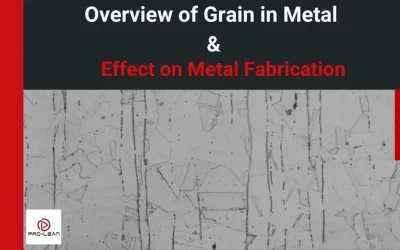
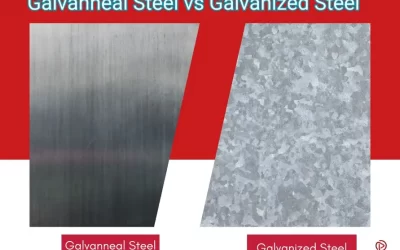
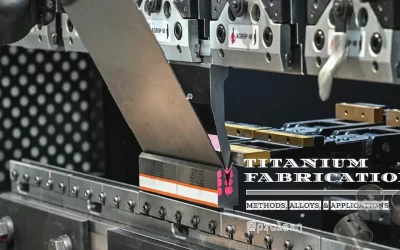
0 Comments